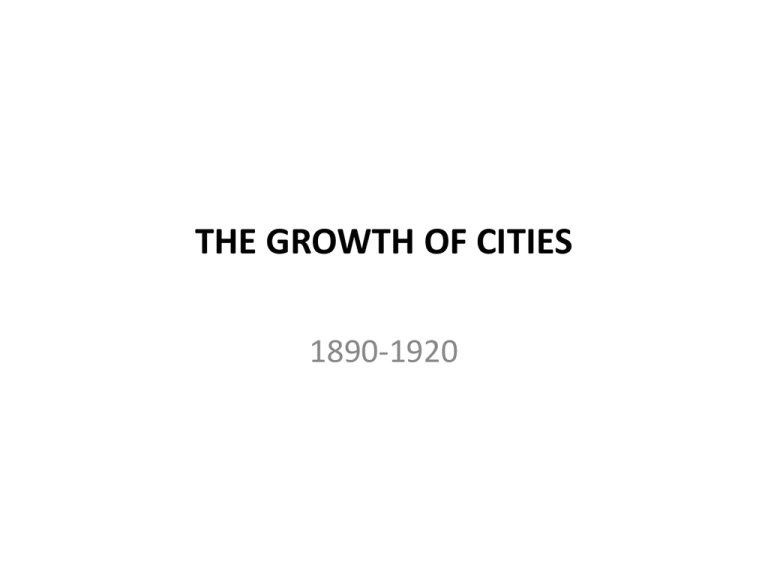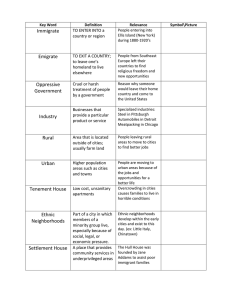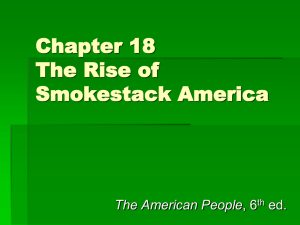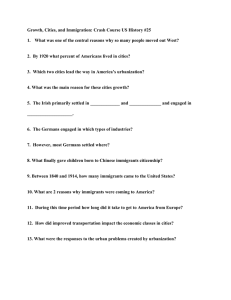THE GROWTH OF CITIES 1890-1920
advertisement

THE GROWTH OF CITIES 1890-1920 URBANIZATION: RAPID CITY GROWTH A. ATTRACTIONS OF CITY LIFE: 1. JOBS - MANY DIFFERENT JOBS AVAILABLE ESPECIALLY IN FACTORIES 2. PUBLIC SERVICES: a. Transportation b. Streetcars c. Subways d. Bridges e. Skyscrapers f. Elevators (all of the above created jobs.) 3. education: a. Public education 1865-1900 - a. Enrollment doubled b. Teachers better trained c. Vocational education added after 1900 b. Libraries c. Museums d. Concert halls e. Etc. CARNEGIE HALL - 1891 4. Cultural Attractions: a. Restaurants b. Theaters c. Baseball parks d. Racetracks beaches B. Problems of City Life: 1. overcrowded – tenements – a substandard multi-family dwelling in the urban core, usually old and occupied by the poor. Tenements offered no ventilation which caused health problems and potential fire hazards. No indoor plumbing, etc. 2. Sanitation: a. Garbage placed on streets b. Water was polluted from all the garbage c. Attracted rats and germs d. Many water born diseases present e. Air pollution from factories 3. Crime: a. A great deal of violent crime in poorer neighborhoods b. Police force did exist but could not keep up with the rising population c. Many gangs related to ethnic groups or occupations d. Poverty encouraged crime e. Slums developed 4. Hospitals - existed but were only affordable to the wealthy. George E. Waring, Jr. Was an American Sanitary engineer and civic reformer. He designed and advocated a sewer system that kept domestic sewage Separate from storm runoff. He also appointed to be the agricultural and drainage engineer for the construction of Central Park. Teddy Roosevelt - 1895-1897 Raymond Kelly – current commissioner C. Impact of urbanization on families: sharp division among classes. 1. Working class – everyone worked, came home only to sleep, and were in low paying jobs. Blue collar workers. 2. Middle class - shopkeepers, doctors, lawyers, and teachers – led comfortable lives. Made enough money to be able to afford to send their children to school. White collar workers. 3. Wealthy – conspicuous consumption – display their wealth so all will notice. D. Ethnic neighborhoods: people tended to live in the same neighborhood as their nationality. Ex. Little Italy, and Chinatown. E. Immigration: 1. “Old immigrants” - 1776-1890 a. Arrived prior to 1890 b. Western frontier wide open c. Most from Northern and Western European countries. 2. “New Immgrants” - 1890-1920 a. Arrived after 1890 b. Settled in urban centers: formed ethnic ghetto neighborhoods c. Western frontier closed d. Most from Southern and Eastern European countries. e. Fled economic depravation and religious persecution 3. Examples of contributions: a. Building transportation systems 1. Chinese 2. Italians 3. Irish 4. Slavs b. Mining – 1. Welsh 2. Poles 3. Slavs c. Textiles 1. English 2. Jews d. Optical Equipment 1. Germans e. Chemical industry 1. French f. Stone masons – sculptors 1. Italians 4. Reasons for Immigration: a. Population pressures - were attracted to the abundance of land b. Recruitment conditions - some industries went abroad to attract workers to come to the U.S. in return for free passage c. Economic conditions – job opportunities d. Persecution - religious - Jewish F. Nativist reaction to the “new immigrants” 1. Opposition: a. Economic reasons – competition for jobs b. Cultural reasons - dominant culture wants to protect their culture against outside or “foreign influences” c. Psychological reasons – need to feel superior to others – often takes a racist or nationalist form xenophobia - fear of foreigners d. Political reasons – fear that immigrants might be connected with radical and revolutionary causes (Russian Revolution)




